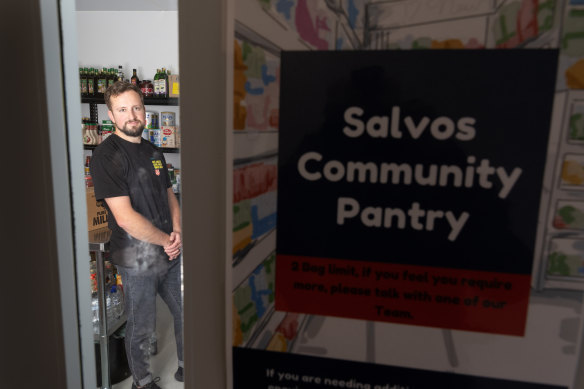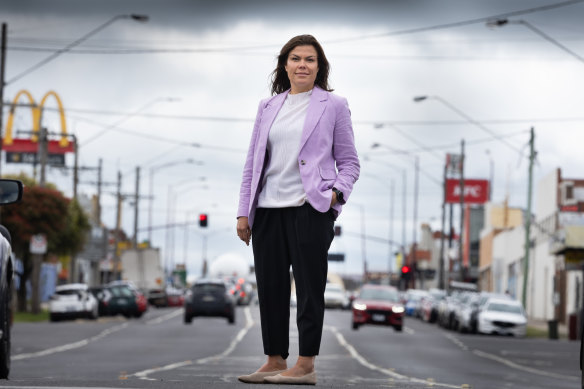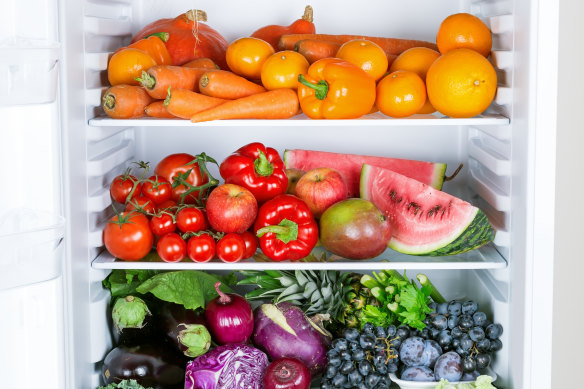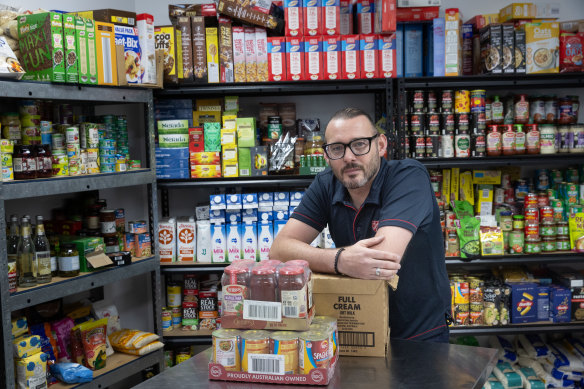This was published 5 months ago
Rural paradox: Surrounded by farms but eating poorly amid rising costs
Josiah van Niekerk has a steady job in a senior position with the Colac Salvation Army, serving an ever-growing number of households seeking food and essentials.
And yet the second-in-charge at the Colac Corps regularly relies on the same food and household supplies he provides for people in need, as pressures mount on his own family budget.

Josiah van Niekerk regularly has to rely on the service he provides to needy people.Credit: Jason South
“There are weeks we use the service I work for,” van Niekerk said. “I encourage our team [to do the same] if times get hard.”
Occasionally, he has needed fresh produce or nappies and baby formula.
Meat is among the food staples in greatest demand and shortest supply at the Salvation Army’s Colac centre in south-west Victoria. This is despite an abattoir processing animals daily just a few hundred metres away.
“We go through plenty of milk and bread. Meat is probably the big one,” van Niekerk said.
Households across Victoria are hurting as the cost-of-living crisis bites. But it hits differently in rural areas where incomes are typically lower, petrol often costs more and many people live far from shops.
Now, Deakin University researchers are trying to understand why many residents in rural Australia struggle to access healthy food despite often living in areas surrounded by agriculture and food production. They say food grown in rural communities is typically destined for Melbourne, even if it is brought back and sold in local supermarkets.
Van Niekerk said the Salvation Army was seeking to partner with local food producers to help feed needy families. The abattoir in Colac, owned by Minerva Foods, was contacted for comment.
Deakin University food retail expert Cindy Needham said one challenge for people in and around Colac was the proliferation of fast food, which seemed more convenient than healthier choices. Many rural households may be unable to prioritise fresh food, she said.
“Their priorities are their rent, petrol, keeping their kids clothed, keeping their heating on,” Needham said.

Deakin University researcher Cindy Needham in Colac. She is trying to help rural communities eat less fast food and get better access to fresh produce.Credit: Jason South
She is leading a team of researchers analysing access to healthy food in the Colac Otway Shire in Victoria, and Tamworth Regional Council in NSW, to understand how rural communities can better feed themselves.
The Colac Otway Shire covers a vast area taking in the mid-sized town of Colac as well as small inland farming communities and coastal destinations, including Apollo Bay.
Needham said fast food and processed meals were often perceived as cheaper and more convenient for people on tight budgets, particularly those who might have to travel long distances to buy fresh produce. “They are inundated with unhealthy options.”
A Deakin University food monitoring tool showed the Colac Otway Shire had 25 unhealthy food outlets per 10,000 head of population, compared with 5.1 healthy food outlets in 2019. There are now at least four major fast food outlets near each other in Colac, including a McDonald’s. However, a McDonald’s spokeswoman said “Maccas is more than a restaurant”, in regional communities.
“We’re owned and operated by franchisees, many of whom have grown up in their communities and who are proud to run local businesses,” she said. She said McDonald’s invested in regional families, producers and suppliers by sourcing 90 per cent of its produce from Australia.
Research backs Needham’s contention that fresh food is less accessible to residents in rural areas. A paper published in the Australian and New Zealand Journal of Public Health in 2021 reported fewer than 10 per cent of people in rural communities met guidelines for vegetable intake.
Needham’s research team is working with communities to co-design a web-based tool that will be available as an app or online to understand where they buy their food.
“We’re looking to communities to help find solutions and innovative ideas. In other countries, they have introduced fresh food vans, community gardens and delivery services.”

Rural communities often lack easy access to fresh produce. Credit: iStock
The researchers want to determine whether local communities can gain better access to the food that is produced around them.
“How can we get it back out there in a sustainable, feasible way that works for these communities?”
While farmers markets are growing in popularity across the regions, they are often not feeding large sections of the population.
The Salvation Army in Colac provides its own weekly market day allowing people in need to fill three shopping bags of fresh produce, frozen meals, meats and pantry goods. Lieutenant Paul Trotter said when he started working at the service three years ago they averaged 30 households on a market day. Last year that number rose to 60.

Paul Trotter in the Salvation Army’s Colac pantry. Credit: Jason South
“This year it’s increased again. The cost of living has definitely done that,” Trotter said.
Charity FoodShare this week called for donations before Christmas in the Albury Wodonga region, saying 15,000 out of 40,000 local households were either worried about running out of food, “compromising on meal choices” or even skipping meals.
“Food insecurity is now affecting households that have never experienced it before,” the group’s chief executive Katrina Pawley said.
Colac Area Health director of research Laura Alston said rural communities experienced poorer health than their city counterparts. “Improving diets in rural areas will lead to better rural health now and for future generations,” she said.
Start the day with a summary of the day’s most important and interesting stories, analysis and insights. Sign up for our Morning Edition newsletter.